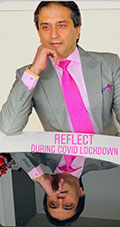
CoronaVirus Pandemic – XV - FINAL

Post Covid – Lessons learned
Although new cases are in decline, the pandemic has driven the patients and their healthcare providers to adopt new ways to manage illnesses. Needless to say, this has been perhaps the most difficult time in the annals of patient management. And going forward, many of these changes in our health care delivery system as discussed below, are here to stay. Welcome to the new normal!
-
Telemedicine: The virtual or zoom visits for medical follow-up care took off during the peak days of Covid-19 and has all but replaced the traditional office visit. Now, the patients have learned to log into their computer or smartphone and discuss current issues with their physicians. And they seem to like it since they can do it conveniently sitting at home. Arrangements for in-person visit can be made as and when necessary.
-
Emergency visits to the hospital and urgent care centers have come down. Unless the situation warrants immediate attention, patients prefer zoom communication with their doctors. One drawback is that occasionally serious problems like impending heart attacks may not get prompt attention, leading to complications. Also, remember that ERs and urgent care centers are already busy these days with a significant delay in seeing patients.
-
The pandemic is likely to continue for some more time and then will remain with us as an endemic popping up during winter time like the flu; so, be ready for annual vaccination. Hope most of you got your booster shots.
-
Symptoms of anxiety and depression among U.S. adults have been amplified ever since Covid-19 started. Initially, it was the ‘confinement anxiety’ from lockdown but even after the rules were relaxed, there is still considerable restrictions to our mobility. Women seem to be more severely affected by the social and economic consequences of the pandemic. So, it’s important to take steps for proper handling of these mental health issues.
-
Sadly, there has been reports of increased domestic violence after the pandemic began. When you have to stay put in with less chance for social outing, there’s likely to be too much closeness that creates a fertile ground for abuse, although it should never be that way. So, beware of the problem and take appropriate remedial action.
-
Children also suffered as frequent school closures kept them away from friends and in-person learning. Although many schools are open now, we don’t know what will happen if and when another surge of the pandemic occurs. However, certain items such as psychological counselling sessions, private tutoring lessons, etc., are still being conducted through zoom. Children are also becoming addicted to iPads and cell phones and weaning away these gadgets from them needs deft handling.
-
‘Working from home’ has become the order of the day and’ ‘going to the office’ as we know now may become a thing of the past. Many companies are now remote-only operations in which employees never collaborate in person. This may lead to loss of a sense of shared empathy, coordination and comradery.
-
"Pandemic posture" is a new problem to contend with. The poor stance from constant slouching at a desk or on a couch that many of us have been resorting to these days can result in back or neck pain. To reduce the pain, exercise daily. Working with a physical therapist to learn the right way to sit up straight and how to strengthen the muscles that support the posture, sitting on a chair with cushioning for the buttocks and support for the lower back, getting a footrest, keeping your computer monitor at eye level and using an ergonomically designed mouse and wrist pad – can be helpful. Also, get up, stretch and walk around for just five minutes every hour.
-
Withering of social life: A lot of relationships have suffered largely because of the inability to get out of the house and move around freely. And many social gathering places have closed down as well that has depleted the joys that make up a human life —and buoy human health. But, in the coming months, as we start meeting and greeting many of our friends and relatives, the situation will improve.
Going forward, don’t panic. All of us need to sharpen up on our own coping skills till life regains a semblance of normality. And continue to observe personal hygiene always.
This ends the series on coronavirus pandemic.
M.P. Ravindra Nathan, M.D., is a cardiologist and Emeritus Editor of AAPI Journal. For further reading, “Second Chance - A Sister’s Act of Love” by Dr. Nathan from Outskirts Press, can be found at www.amazon.com
EYE CARE
Happy Deepavali: Beyond Sparklers, do your peepers sparkle?

In my previous column, I explained the concept of cataracts and how not to wait till they mature or till you are “Blind enough.”
Our eyecare industry continues to innovate and bring out new lens implant technologies to keep up with vision demands and changing vision goals of the new generation of patients looking forward to live longer than their ancestor and, that too, with vision freedom.
Let’s understand some new terminologies of proprietary surgical techniques I have invented to raise the bar on current eye surgical concepts, techniques and technologies.
LenzOplastique™ is a next generation, no pain, no stitch, no injection, no drugs, vision-optimized cataract surgery in a calm, soothing, personalized ambience where everything from instrumentation to lens implant technology is tailored to individual eyes and vision goals.
LlaZrPlastique®: Next-generation Lasik surgery with no cuts, no blades and no flaps that can safely and effectively correct any associated vision glasses prescription before or after cataract surgery.
Corneoplastique®: Cornea-based noninvasive laser techniques to correct patients with complications of cataract and Lasik surgery.
The U.S. FDA-approved lens technologies may be the best investment you can make during this festival season of “spend and plenty.” Especially, if you are over 58 years of age and have been diagnosed with cataracts.
This is also a great time to live for those over 40 years of age and dependent on those pesky reading glasses. The currency of spoil and grandeur has changed from “material” to “experience” and never before so high, as your own custom-designed vision to enjoy the rest of your life with.
Summary of answers to most commonly asked questions by cataract patients:
-
Do I have to wait till my cataracts ripen/mature? No, not anymore! In fact if you wear glasses for any reason, nearsightedness, farsightedness or astigmatism, as long as your eyes are healthy, you don’t need to wait to start seeing clearly without glasses (LenzOplastique™).
-
Why was I given so many confusing choices for lens implants for my cataract surgery? Your cataract having been a lens needs to be replaced with an artificial lens and there are over 34 different lens technologies available in the U.S. and nearly 81 worldwide. Do your research and don’t fall for only two or three choices. Ask questions and explain your vision goals to the eye doctor.
-
Why am I wearing glasses after cataract surgery? In some cases, you may have some glasses’ number despite surgery and this can be successfully corrected using modern laser vision surgery techniques like LaZrPlastique®
-
What if I have a corneal problem like Keratoconus or previous Radial Keratotomy surgery? Can I still have cataract surgery? Yes, you certainly can and even, in such cases, result in vision without glasses with proper planning and technology choices.
-
Can complications of cataract surgery be corrected? As long as your retina is fine and potential to see is maintained, most complications of cataract surgery can be successfully corrected to excellent vision not only for anatomical damages but also for vision using staged Laser Corneoplastique® techniques.
This Diwali, the riches to compare and flash is neither diamonds nor gold. The present currency is the lens implant for your cataract surgery. The cost of the implant is a direct correlate to how much your loved ones really love you.
So, you go to your eye doctor’s office and are diagnosed with cataracts. Before you can mourn about this obvious testimonial to having aged, you are given a menu of lens implants to choose from – a full range of affordable to magical!
You leave the eye doctor’s office scratching your head and turn to your trusted source of medical information: Google!
Industry already knew that would be your only recourse and built widespread advertisement campaigns online so you are smothered with choices explained in terms they hope challenges your aging brain enough to help you succumb to the shiniest and most expensive technology. This you somehow justify as a mark of wealth that could still invoke the gods in all their glory; during Deepavali (Diwali).
Ok, let’s get serious.
This is the most confusing thing many patients today face once diagnosed with cataracts. What lens implant to choose and how to understand their impact on their vision.
I have previously written about how you as a patient should take charge of your particular eye health and vision goals and then let the surgeon assist in selecting the best implant.
All of us understand that during cataract surgery, the cataract is removed, and an artificial lens implant is inserted in the eye. Until recently, there were no choices and life was simple – boring and monofocal!
With technology innovations, we have lens implants that include Multifocal (Progressive), Trifocal, Extended depth of focus (EDOF), X wave technology, etc., to help you see distance and near; Toric (to correct astigmatism), photocell and even re-chargeable (like I have described in previous columns). A thorough exam of your eye, including its optics and health, can help decide which lens implant will most likely result in vision without glasses at distance and near.
I encourage you to believe that your surgeon is more knowledgeable than Google and you must ask questions about pros and cons and possible expectations. How the lens implant chosen for you works and how will that translate to vision for your individualized goals. What are the possible side effects and what solutions are available? Also, have you been offered all lens implants choices available or only those available with that surgeon/office?
Do clearly outline your vision goal (distance vision, near vision or both and do you have to have perfect night vision, etc.)
Most usually, a combination of your vision goals along with the surgeon’s selection of the lens implant in your best interest can lead to a satisfactory outcome. Anything less than this and you may become a statistic.
Emotions usually run high because of the cost of the implants beyond insurance and hence expectations must be clear before surgery.
Poor lens implant choices can lead to haloes and star bursts that can challenge the splendor of many a Deepavali lights.
By the same token, proper selection of the lens implant and surgical technique is one of the most gratifying surgical outcomes in modern medicine with a vision outcome that lasts a lifetime with well-earned bragging rights enough to divert the attention from Solitaires and Rolexes to the proud shimmer of your eyes.
This Deepavali, I can envision groups of richly dressed people looking into each other’s eyes comparing their sparkles and testing vision at all distances even before drinks are served.
Go ahead and light the sparklers but get the Sparkle back in your eyes!
Arun C. Gulani, M.D., M.S., is director and chief surgeon of Gulani Vision Institute in Jacksonville. He can be reached at [email protected] or visit www.gulanivision.com